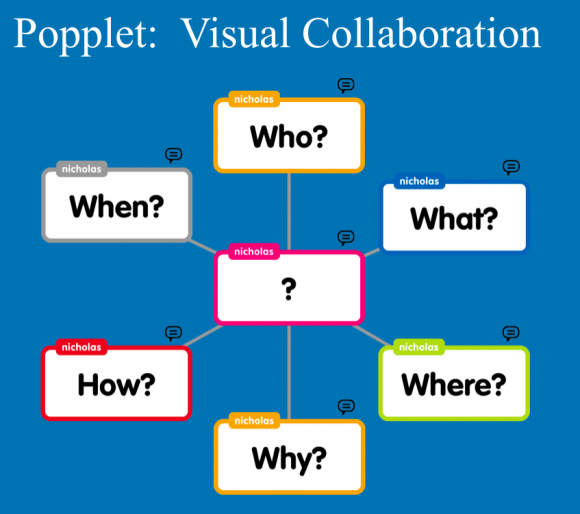Popplet is a much-loved app amongst startup entrepreneurs, web designers, creative professionals and new technologists who need access to collaborative tools (online and on their iPads) that reflect how they think visually.
But what about more established and traditional businesses who are having difficulties incorporating new ways of thinking and new collaboration techniques into the ways they work? Can they benefit from using Popplet in their organizations?
Collaboration tools are being considered more and more essential in the business context. Research by the McKinsey Global Institute found that social collaboration tools are becoming essential for businesses that want to increase productivity and drive a new wave of innovation.
These businesses are looking for ways to encourage diverse teams to work together in realtime (across remote locations), and want to use online and iPad apps that can help ignite a sense of creativity amongst the project team. Businesses want tools that can be used across project planning, implementation, monitoring and review.
 Nicholas McGill is the Creative Director and Founder of Heroik Media, a business and innovation consulting firm. He leads a team of seven global thought leaders who work across a range of industries to help businesses communicate with their audiences and build their brands.
Nicholas McGill is the Creative Director and Founder of Heroik Media, a business and innovation consulting firm. He leads a team of seven global thought leaders who work across a range of industries to help businesses communicate with their audiences and build their brands.
Nicholas and his team often work with established businesses who may have begun to stagnate or have gotten used to their current ways of doing things. …And they are using Popplet to create the transformational change that is helping these businesses succeed.
While the rest of the business landscape is grappling with ways to enter new markets, use technology and data to drive new innovation and meet customer demands for personalization and realtime responses, many established businesses can take on the ‘ostrich-head’ strategy and just bury their heads and ignore the need to reorient the way they do business. To help these businesses activate a new growth spurt often means building a culture of change that everyone across the business can connect with and feel a part of.
In this first part of our latest Popplet People profile, we speak with Nicholas about how he uses Popplet to overcome the resistance that may be holding some organizations back from thinking about their next stage of growth. (In Part Two, Nicholas will share some of the specific techniques he uses in Popplet, including color coding techniques, second screen management, Popplet’s time warp feature and Popplet Presenter mode.)
Transforming and growing businesses with Popplet
“Heroik Media are a consulting company that builds growth engines for business,” Nicholas tells us. “Our process breaks the system and ignores the mold to work holistically across the organization. You can’t transform a company without addressing the soft infrastructure — the people and the organizational culture.
“This means strategically including and guiding teams that foster co-ownership of business projects. Many of these business teams, who in a traditional sense, might not be relevant to the immediate project in the near term will ultimately drive the success of the organization. It comes down to creating transformative, collaborative experiences that establish co-ownership of whatever we’re bringing to the table.”
Nicholas and the Heroik Media team often use Popplet to help their business customers build momentum for new projects or to help drive cultural change so that new organizational growth can occur.
Getting business heads to start nodding quickly
“Introducing our clients to new tools that are simple, digital, and collaborative adds a level of flow to the organization. If done correctly, this gets heads nodding quickly in your direction. It’s like handing them a valuable asset for free, and from a sales/buy-in perspective, gets you a series of ‘yes’es before sharing the idea. By that I mean, since Popplet is so simple and un-intimidating, it’s easy to get people to jump in and brainstorm.
“So we used it to rope in the key players (influentials) and show social proof as we were moving forward. Popplet became a visualization of the transformation and momentum and helped decrease resistance. So even naysayers were more likely to go with the flow.”
How Popplet helps overcome the fear of change
Nicholas uses a Popplet technique that lets those who are resistant to the new project to also have a voice:
“Sometimes, we make islands on a Popplet for the naysayers. We create a popple called ‘Objections and Concerns’ and invite the resistant to unleash and unload. This serves multiple purposes:
- It puts parts of the discovery on auto-pilot: it fleshes out the important concerns and objections, and identifies the objectors
- It exorcises the demons — it allows people to vent — sometimes, that’s all that’s needed
- It creates the ‘against’ team, who we collaborate with and facilitate with. We help the negatives express their ideas clearly, and this brings us onto their team.
“We use color and spatial psychology to be admittedly a bit unfair to these naysayers on Popplet. There’s a difference between people with concerns and critical issues and those who are opposed to any change (which is unfair to us and the clients who hire us). So we’ve rigged the system. We allow the naysayers to use any color in Popplet, so long as it’s black!
“Imagine seeing a big island of black popples, juxtaposed by a bigger multi-color continent of fun. Where do you want to play? So slowly but surely, we address objections and integrate the island into the whole Popplet project. We make our clients map themselves back on the productive side of the discussion.
“Business therapy is part of our job. I mean it. We study it along with neuroscience, behavioral economics and countless other things. So Popplet becomes another tool of business therapy to work through past pain, fear, objection and brings everyone to a growth-minded place. You can’t do this, or be as effective or productive, with more complex tools. Many organizations have a lot to work through before they can graduate to other forms of collaboration.”
How Popplet helps prepare businesses for growth
“Here’s the thing,” Nicholas reminds us. “The instant a business’ staff start participating on the platform, you’ve already won more than half the battle. This is yet another reason Popplet helps us rig the system to ensure our clients are more productive and poised for transformation and growth. You see, at a cognitive level, when you enjoy doing something — even venting or voicing objections — you’re already in a compromised position.
“Our brains are hard-wired to desire happiness, so if our brain senses joy in an act, all we have to do is nudge and suggest there is more fun to be had over here. This is the interactive experience equivalent of getting a series of ‘yes’es when you’re trying to sell something. If we can bridge negative emotions to positive interaction, we can create a playing field to associate positively with new concepts.
“Creating buy-in increases productivity manyfold. By visualizing momentum, introducing helpful and easy-to-use tools, and inviting naysayers to voice objections and concerns, we have used Popplet to get and show early buy-in.”
Our interview with Nicholas McGill, Creative Director of Heroik Media will continue next week. In the meantime, you can check out his blog post on how he uses Popplet with his creative teams.
Would you like to be featured in our Popplet People profiles? Tweet us your details or contact us on Facebook and we will get in touch!

